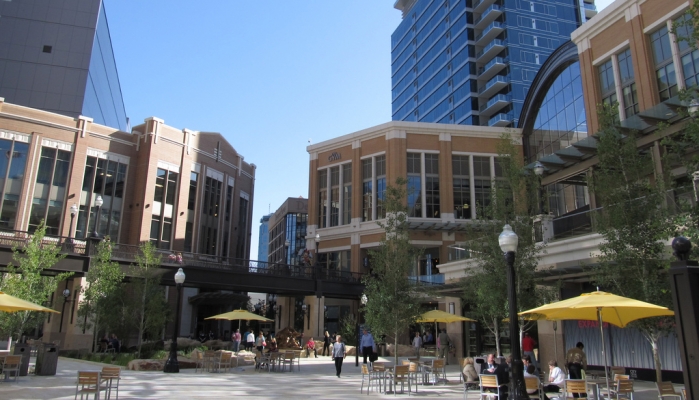Metropolitan centers emerge as smart growth solution

A new NITC report examines metropolitan centers: high-density developments in metropolitan regions.
Mixed-use transit-oriented developments are one example of a metropolitan center, but high-density developments in suburban areas without transit also fit the definition.
Across the country, metropolitan planning organizations (MPOs) are steering cities toward this type of development for a variety of reasons.
Many of them are facing the same constraints: poor air quality and increased congestion without an increase in dollars to solve it. One response to the problem involves getting a better handle on land use.
NITC researchers Richard Margerum and Rebecca Lewis of the University of Oregon and Keith Bartholomew of the University of Utah evaluated the planning process surrounding metropolitan centers in two case study regions, Denver and Salt Lake City.
“A lot of regions are paying attention to regional growth patterns. How do you do this at a regional scale when you don’t have the authority? What planners and MPOs are really facing is the question of how to support the adoption of these kinds of concepts,” Margerum said.
The goal of the study was to examine this topic on two levels.
First, researchers sought to learn how and why local governments have adopted the concepts of urban centers over time.
Second, they wanted to understand how demographics, land use, and transportation choices have changed over time in the designated centers.
“What we’re trying to look at in more fine-grained detail is the variety of what those centers are like today, and what the local government’s intent is going forward. Some areas are different; jurisdictions are responding in different ways. Some suburbs are really running with this concept, others are kind of reluctantly going along with it,” Margerum said.
Both of the case study regions have adopted voluntary regional policies for promoting smarter growth, and they rely on regional consensus and collaboration rather than a state growth management framework.
“Regional livability goals and also transportation funding incentives have been a motivator for a lot of communities,” Margerum said.
Market forces have been another strong motivator.
Millennials are generally more attracted to a walkable, urban living experience than previous generations, and developers hope to draw them in with density, as well as employers who seek out urban locations so their employees will have access to transit.
Denver and Salt Lake City offer an interesting context for this work, because they typify some of the current challenges and future potential opportunities facing metropolitan regions, including rapid growth, air quality concerns, low-density urban form, and a significant investment in mass transit.
Across both regions, there is increasing use of the concept of metropolitan centers, including urban centers and transit-oriented development.
The Denver metropolitan region has included the concept as part of its regional plan since 2000 and included it in its transportation funding criteria since 2008. In the Salt Lake City area, a regional vision of centers did not emerge until 2005 and was not part of transportation funding criteria until 2015.
There has also been gradual change in the vision of these centers over time. They have evolved from centers of single-use activity (such as employment or retail) to mixed-use centers offering more urban amenities.
This evolution is occurring more quickly in some cities than others and, in general, cities in the Denver region are further along than the Salt Lake City region.
For many jurisdictions, transit investment is the important catalyst to initiate this transformation, although some planners argued this could occur in areas without transit.
To learn more about this research, visit the project page or download the final report.
